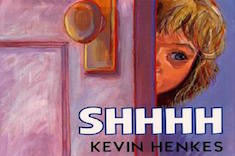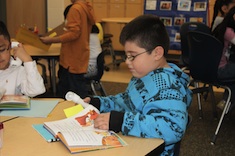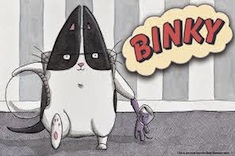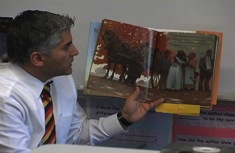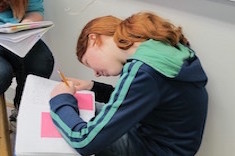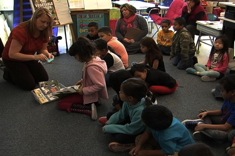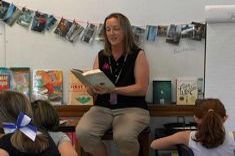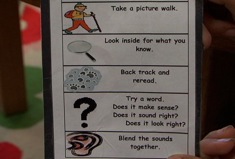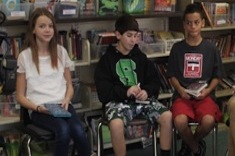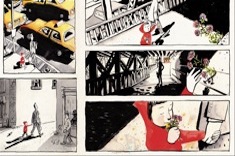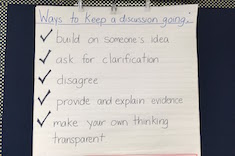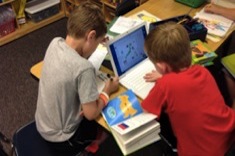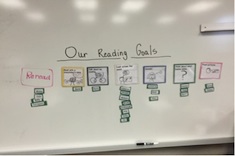Reading Strategies
Are your students buried in post-its? Oversharing with those text-to-self connections? Parroting back comprehension tips but rarely applying them when they are actually reading? Our contributors sort through what works with strategy instruction, and have wise advice for avoiding superficial approaches to developing comprehension skills.
Latest Content
Using Read Alouds to Build Fluency
Tara Barnett and Kate Mills find an ingenious way in the upper elementary grades to help their struggling readers develop fluency through read alouds.
The Power of Picture Book Conversations
Katie DiCesare uses conversations around picture books to build communication, community, and reading skills in her first-grade classroom. Late in the school year she reflects with students about why these conversations are so powerful.
Thinking About Fluency
Cathy Mere finds that with young learners, not all issues with fluency are created equal—different needs require different strategies.
Putting the “Gradual” Back into Gradual Release of Responsibility
If it’s not sudden release of responsibility or no release of responsibility, what does gradual look like? Clare Landrigan and Tammy Mulligan bring this model to life.
#articleaday
Justin Stygles uses a daily nonfiction article activity as a way to build interest in nonfiction short texts, especially among reluctant readers in his classroom.
Graphic Novels for Beginning Readers
If you are looking to increase the quantity and quality of graphic novels for your learners in your classroom library, Shari Frost has a new booklist to get you started.
Deep Reading of Picture Books in Middle School
Christy Rush-Levine shows the power of using picture books with young adolescents to model close reading and deepen comprehension of sophisticated texts.
Kindergarten Reading Conference: Building Confidence
Mandy Robek finds that kindergartner Mikey is lost in knowing how to use his time well during reading workshop. Her conference moves him from deflated to inspired.
Extended Inquiry with Article of the Week
Gretchen Schroeder finds the article of the week activity is an excellent vehicle for learning about content literacy gaps in student background knowledge and how to fill them.
Understanding Character Traits: Part 3
Jason DiCarlo completes his lesson on character traits in third grade. This is the final installment in a three-part series.
Teaching Inference Through Picture Books
Katherine Sokolowski explains why picture books are useful for teaching inference to intermediate students, and shares some of her favorites.
Stamina Bubbles
“Why do you always say ‘Happy reading!’ to us?” This question from a first grader leads Katrina Edwards to develop visual support tools for building stamina during reading workshops.
Literary Analysis and Authenticity in Middle School
Christy Rush-Levine finds the best way to help her middle school students learn to read closely for literary analysis is through student writing. They begin with analyzing student exemplars from the Common Core, and then move to shared texts as they hone their skills.
Close Reading for Comparison in Fifth Grade
Katherine Sokolowski uses a fascinating picture book to build close reading skills with her fifth graders. The key is selecting a text that holds up well through multiple readings.
Close Encounters with Text: Reading Many Ways
Jan Burkins and Kim Yaris find their reading processes as adults informs the way they view close reading with students.
Beginning a Novel with Close Reading
Aimee Buckner helps a fourth-grade boy tease out emerging themes in the first pages of the novel Morning Girl.
Understanding Fiction and Nonfiction in First Grade
This is a demonstration lesson in a first-grade classroom on understanding the difference between fiction and nonfiction led by Erin Quealy. It is the first video in a three-part series.
Second-Grade Reading Group
Heather Rader demonstrates the importance of a varied reading diet to a second-grade group, sharing her own stack of books.
Just Reading?
Christy Rush-Levine challenges the notion that there is anything easy or natural about getting young teens to select and read books independently in classrooms.
Fourth-Grade Read Aloud: Checking In
In this video from a fourth-grade classroom, Gi Reed reads aloud Small as an Elephant by Jennifer Richard Jacobson. Gi continually checks in with her students, making sure they are visualizing, noticing new vocabulary, and making connections to earlier incidents in the texts—all without breaking the flow of the story.
Using a Strategy Card in a Reading Conference
Deb Gaby confers with second grader Reagan early in the school year. She is reading her first chapter book, and using a reading strategies “tool kit” for support.
Book Clubs Then and Now: Change Is the Constant
Mary Lee Hahn considers how book clubs have changed over time in her fifth-grade classroom.
Provoking Young Readers
Melanie Meehan finds read aloud is a great time for children to connect opinions and experiences.
Owl Research Notes Group
Andrea Smith helps a group of boys take notes during an owl research project.
Favorite Wordless Picture Books for Teaching Inference
Jan Burkins and Kim Yaris present some of their favorite children’s books for teaching inference.
Working Hard and Reading Carefully: On Theme and Rereading
Jennifer Allen uses commercials to promote the importance of rereading to students while teaching theme.
Supporting Readers with Nonfiction Text
Cathy Mere finds that criteria for “just-rightness” varies with genre.
Redefining Just-Right Books
Jan Burkins and Kim Yaris share advice for rethinking how teachers and students define “just-right” texts.
Setting Goals with Students
Melanie Meehan shares anchor charts and strategies for goal-setting.
Intervening with Read Aloud
Jan Burkins and Kim Yaris are using read alouds as an intervention strategy with struggling learners.
Browse Content By
Type
Category
- Assessment Tools
- Big Fresh Archives
- Booklists
- Choice Numeracy
- Classroom Design
- Common Core
- Community Building
- Conferring
- Content Literacy
- Digital Literacy
- English Language Learners
- Equity
- Family Relations
- Free Samples
- Guiding Groups
- Leadership
- Literacy Coaches
- Mentor Texts
- Minilessons
- New Teacher Mentors
- Podcasts
- Poetry
- Quote Collections
- Reading Strategies
- Self Care
- Struggling and Striving Learners
- Talking and Listening
- Teacher Study Groups
- Teaching Reading
- Teaching Writing
- Word Study and Vocabulary
Author
- Melissa Quimby
- Nawal Qarooni
- Gwen Blumberg
- Julie Cox
- The Lead Learners
- Hannah Tills
- Josie Stewart
- Ruth Metcalfe
- Mallory Messenger
- Becca Burk
- Jodie Bailey
- Vivian Chen
- Mary Brower
- Tiffany Abbott Fuller
- Stephanie Affinito
- Ruth Ayres
- Leigh Anne Eck
- Heather Fisher
- Shari Frost
- Julie Johnson
- Suzy Kaback
- Gigi McAllister
- Shirl McPhillips
- Melanie Meehan
- Cathy Mere
- Debbie Miller
- Tara Barnett and Kate Mills
- Tammy Mulligan
- Dana Murphy
- Bitsy Parks
- David Pittman
- Brenda Power
- Heather Rader
- Matt Renwick
- Mandy Robek
- Christy Rush-Levine
- Gretchen Schroeder
- Jen Schwanke
- Brian Sepe
- Katherine Sokolowski
- Stella Villalba
- Jennifer Vincent
Grade Level
Choice Literacy Membership
Articles
Get full access to all Choice Literacy article content
Videos
Get full access to all Choice Literacy video content
Courses
Access Choice Literacy course curriculum and training

